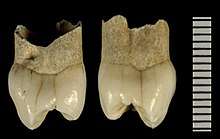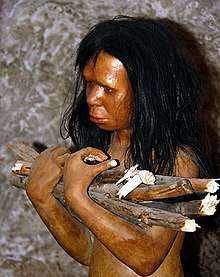Wezmeh Child
Wezmeh Child or Wezmeh 1 represented by an isolated unerupted human maxillary right premolar tooth (P3 or possibly P4) of an individual between 6–10 years old. It was found with large numbers of animal fossil remains [1] in a cave site called Wezmeh near Islamabad Gharb, western Iran, around 470 km (290 mi) southwest of the capital Tehran. The site was discovered in 1999.[2]


The premolar is relatively large compared with both Holocene and Late Pleistocene P3 and P4.[3] Researchers analyzed it by non-destructive gamma spectrometry that resulted in a date of around 25,000 years BP (Upper Paleolithic). But later analysis showed that the gamma spectrometry dates the date was minimum age and the tooth is substantially older. Endostructural features and quantified crown tissue proportions and semilandmark-based geometric morphometric analyses of the enamel-dentine junction aligns it closely with Neanderthals and shows that it is distinct from the fossil and extant modern human pattern. Therefore, it is the first direct evidence of Neanderthal presence in the Iranian Zagros.[4]

Given that the cave was a carnivore den during late Pleistocene, it is probable that the Wezmeh Child was killed, or had its remains scavenged, by carnivores who used the cave as den. Within an approximate 30 km radius of the Cave, 13 Middle Paleolithic sites have been recorded; among them, the nearest sites are located about 10 km to the northwest.[5] The tooth is on display at Paleolithic gallery of National Museum of Iran
References
- Mashkour, M.; Monchot, H.; Trinkaus, E.; Reyss, J.-L.; Biglari, F.; Bailon, S.; Heydari, S.; Abdi, K. "Carnivores and their prey in the Wezmeh Cave (Kermanshah, Iran): a Late Pleistocene refuge in the Zagros". International Journal of Osteoarchaeology. 19 (6): 678–694. doi:10.1002/oa.997. eISSN 1099-1212. ISSN 1047-482X.
- Abdi, K., F. Biglari, S. Heydari,2002. Islamabad Project 2001. Test Excavations at Wezmeh Cave. Archäologische Mitteilungen aus Iran und Turan.34, 171-194.
- Trinkaus, E.; Biglari, F.; Mashkour, M.; Monchot, H.; Reyss, J. L.; Rougier, H.; Heydari, S.; Abdi, K. (2008). "Late Pleistocene human remains from Wezmeh Cave, western Iran". American Journal of Physical Anthropology. 135 (4): 371–8. doi:10.1002/ajpa.20753. PMID 18000894.
- Zanolli, Clément, Fereidoun Biglari, Marjan Mashkour, Kamyar Abdi, Herve Monchot, Karyne Debue, Arnaud Mazurier, Priscilla Bayle, Mona Le Luyer, Hélène Rougier, Erik Trinkaus, Roberto Macchiarelli. (2019).
Neanderthal from the Central Western Zagros, Iran. Structural reassessment of the Wezmeh 1 maxillary premolar. Journal of Human Evolution, Vol: 135.
 Neanderthal tooth on display at an exhibition in conjunction with 17th annual conference of Iranian Archaeology held at Iran National Museum, February 2020
Neanderthal tooth on display at an exhibition in conjunction with 17th annual conference of Iranian Archaeology held at Iran National Museum, February 2020 - Biglari, F., Abdi, K., 1999. Paleolithic artifacts from Cham-e Souran, the Islamabad Plain, Central Western Zagros Mountains, Iran. Archaologische Mitteilungen aus Iran und Turan 31, 1e8.